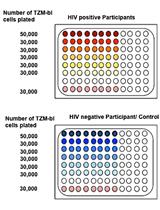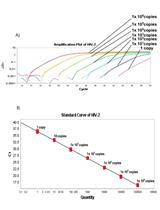- EN - English
- CN - 中文
Analysis of Early Phase HIV-1 Replication and Integration Events by Using Real-time PCR
利用实时PCR对早期HIV-1复制和整合过程进行检测
发布: 2019年02月20日第9卷第4期 DOI: 10.21769/BioProtoc.3168 浏览次数: 6774
评审: Marielle CavroisDaniela BoehmPooja Saxena

相关实验方案

TZA, 一种基于敏感报告因子细胞学检测方法, 可用于准确快速量化静息CD4+ T细胞中可诱导的且复制能力强的潜伏HV-1
Anwesha Sanyal [...] Phalguni Gupta
2019年05月20日 7731 阅读
Abstract
Upon entry into a host cell, the HIV-1 virus undergoes a series of critical early replication events including reverse transcription, nuclear import, and integration of its cDNA into the host genome. Molecular assays used to detect and analyze changes in HIV-1 early phase replication events are valuable tools in developing potential antiretroviral drugs, as well as studying the pathogenesis of HIV. Described here are the molecular assays utilized to detect and quantify HIV-1 early, intermediate, and late reverse transcription (RT) products. In addition to this, protocols for quantifying HIV-1 2-LTR circle DNA and proviral DNA after integration are also included. In these protocols, the optimized TaqMan Real-time PCR reagent is used to increase assay sensitivity and reproducibility. Furthermore, a nested PCR is applied to HIV-1 integration quantification with increased accuracy.
Keywords: HIV-1 (HIV-1)Background
After binding to the receptor and fusing to the host cell’s lipid bilayers, the HIV-1 nucleoprotein complex first enters the cytoplasm, crosses the nuclear envelope, and finally integrates the reverse-transcribed HIV genome into that of the host cell. During this early phase of replication, HIV-1 converts its single-stranded RNA genome into linear double-stranded DNA in cytoplasm by an intricate reverse transcription process (Hu and Hughes, 2012). After nuclear import, some of these linear viral genomes are integrated into the host chromatin. These are termed proviruses. The remaining cDNA that fails to integrate is circularized into either 1-LTR circle DNA or 2-LTR circle DNAs (Sloan and Wainberg, 2011). HIV-1 can counteract various host restriction factors that can interfere with its early phase replication events (Zheng et al., 2012). Molecular assays used to detect and analyze changes in HIV-1 early phase replication events are valuable tools in studying HIV pathogenesis and in developing potential antiretroviral drugs. We report here methods to quantitatively analyze several critical events during HIV-1 early phase replication by using Real-time PCR. The early, intermediate and late stages of reverse transcription events are represented by the initiation of HIV-1 minus strand DNA synthesis, the elongation of minus-strand DNA synthesis following transfer of minus strand DNA, and the synthesis of complete double-stranded linear viral DNA after plus-strand DNA transfer respectively. Given that 2-LTR circles are exclusively found in the cell nucleus, they have become a useful marker of viral nuclear import (Sloan and Wainberg, 2011). As shown in Figure 1, a nested PCR is utilized to quantify HIV-1 integration with increased sensitivity and specificity. Since Alu sequences are the most abundant repetitive DNA, containing over one million copies dispersed throughout the human genome, the 1st round of PCR is designed to amplify a fragment between the integrated HIV-1 gag gene and the host genomic Alu sequence element. Both forward and reverse Alu PCR primers are used in 1st round Alu-gag PCR, since either orientation of Alu sequence can exist in human genome. To avoid the amplification of unintegrated HIV-1 cDNA, the 5’ end of 1st PCR gag R primer is tagged with a unique R sequence. Only the 1st round PCR amplicons containing the R sequence can be used as templates in the 2nd round of Real-time PCR. The optimized TaqMan Real-time PCR reagent is used to increase assay sensitivity and reproducibility. All PCR primers, probe sequences, and their amplicon locations are listed in Table 1.
Figure 1. A nested PCR for quantification of HIV-1 integration
Table 1. A list of sequences of PCR primers and probes
Materials and Reagents
- Axygen® MicroVolume Extended-Length Filtered Pipet Tips (Axygen, catalog number: TXLF10)
- Axygen® Universal Fit 100 µl Filtered Pipet Tips (Axygen, catalog number: TF100RS)
- Axygen® Universal Fit 200 µl Filtered Pipet Tips (Axygen, catalog number: TF200RS)
- Axygen® Universal Fit 1,000 µl Filtered Pipet Tips (Axygen, catalog number: TF1000LRS)
- Axygen 1.5 ml Snaplock Microtubes (Axygen, catalog number: MCT150CS)
- 10 cm cell culture dish (Celltreat, catalog number: 229621)
- 24-well plate (Celltreat, catalog number: 229123)
- MicroAmp Fast Optical 96-well Reaction Plate (Thermo Fisher, catalog number: 4346907)
- MicroAmp Optical Adhesive Film (Thermo Fisher, catalog number: 4311971)
- 0.45-μm-pore-size filters (Thermo Fisher, catalog number: EMD MilliporeTM SLHV033RS)
- Ach2 cells (NIH AIDS Reagent Program, catalog number: 349)
- HEK-293 Cells (NIH AIDS Reagent Program, catalog number: 103)
- Opti-MEMTM (Thermo Fisher, catalog number: 31985062)
- X-tremeGENE 9 DNA Transfection Reagent (Sigma, catalog number: 6365779001)
- The vesicular stomatitis virus G protein (VSV-G) expression vector pVSV-G (Clontech Laboratories, catalog number: 631530)
- HIV-1 plasmids pNL4-3 env(-)nef(-)gfp(+) (a gift from Dr. Vicente Planelles)
- DNeasy Blood & Tissue Kit (QIAGEN, catalog number: 69506)
- TaqManTM Universal PCR Master Mix (Thermo Fisher, catalog number: 4324018)
- TaqMan Fast Advanced Master Mix (Thermo Fisher, catalog number: 4444557)
- Platinum Taq DNA polymerase (Thermo Fisher, catalog number: 10966026)
- Custom PCR primers and TaqMan probes, HPLC purified (Integrated DNA Technologies)
- Turbo DNase (2 U/µl) (Thermo Fisher, catalog number: AM2238)
- Dulbecco’s Phosphate Buffered Saline (PBS) (Sigma, catalog number: D8537)
- 10% Fetal Bovine Serum (FBS) (Gibco, catalog number: 10438026)
- Penicillin-Streptomycin (Gibco, catalog number: 15070063)
- Dulbecco’s Modified Eagle’s Medium (DMEM) (Sigma, catalog number: D6171)
- Absolute Ethanol (200 proof) (Fisher Scientific, catalog number: BP2818100)
- Water (Sigma, catalog number: W4502)
- MgCl2 (Thermo Fisher, catalog number: 10966026) (It comes in with the Platinum Taq DNA polymerase)
Equipment
- 0.5-10 µl Eppendorf Research® plus Adjustable Volume Pipettes (Eppendorf, catalog number: 3123000020)
- 10-100 µl Eppendorf Research® plus Adjustable Volume Pipettes (Eppendorf, catalog number: 3123000047)
- 20-200 µl Eppendorf Research® plus Adjustable Volume Pipettes (Eppendorf, catalog number: 3123000055)
- 100-1,000 µl Eppendorf Research® plus Adjustable Volume Pipettes (Eppendorf, catalog number: 3123000063)
- Revco Laboratory CO2 Incubator Ultima II (Thermo Fisher, catalog number: RCO3000T9V)
- Vortex-Genie 2 Vortex Mixer 12 (Scientific Industries, catalog number: 12-812)
- NanoDropTM 2000 Spectrophotometer (Thermo Fisher, model: NanoDropTM 2000, catalog number: ND-2000)
- StepOnePlusTM Real-Time PCR System (Thermo Fisher, catalog number: 4376600)
- Veriti® 96-Well Thermal Cycler (Thermo Fisher, catalog number: 4375786)
- Eppendorf Centrifuge 5430R (Eppendorf, model: 5430R)
- Eppendorf Centrifuge 5424R (Eppendorf, model: 5424R)
Software
- StepOne software v2.2.2 (Thermo Fisher)
Procedure
文章信息
版权信息
© 2019 The Authors; exclusive licensee Bio-protocol LLC.
如何引用
Graf, L., Moran, S. P., Ro, S., de Noronha, C. M. and Shi, B. (2019). Analysis of Early Phase HIV-1 Replication and Integration Events by Using Real-time PCR. Bio-protocol 9(4): e3168. DOI: 10.21769/BioProtoc.3168.
分类
微生物学 > 微生物细胞生物学 > 基于细胞的分析方法
分子生物学 > DNA > DNA 定量
您对这篇实验方法有问题吗?
在此处发布您的问题,我们将邀请本文作者来回答。同时,我们会将您的问题发布到Bio-protocol Exchange,以便寻求社区成员的帮助。
Share
Bluesky
X
Copy link











